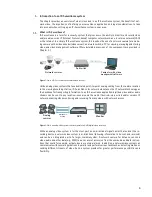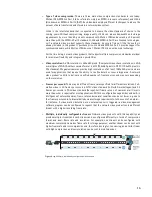
4
Figure 1.1.c.
A network video system with alarm integration
Because of the digital nature and method of video distribution, IP-Surveillance provides a host of ben-
efits and advanced functionalities that gives you greater control and management of live and recorded
video, as well as alarm events. This makes the system highly suited to security surveillance applications.
The advantages include:
1)
Remote accessibility:
You can access live and recorded video at any time and from virtually any
networked location in the world. Multiple, authorized users at different locations may be able to
access live or recorded video. This is advantageous if your company wants a third-party, such as a
security firm, to benefit from and have access to the video. In a traditional analog CCTV system,
you need to be in a specific, on-site monitoring location to view and manage video, and off-site
video access would not be possible without some additional equipment, such as a video encoder or
a network DVR (digital video recorder).
2)
High image quality:
High image quality is essential in a security surveillance application. You want
to be able to clearly capture an incident in progress and identify persons or objects involved. In a net-
work video system, the quality of images produced can be more easily retained than in an analog sur-
veillance system. With an analog video system, the captured images are degraded with every conversion
that the images make between analog and digital formats and with the cabling distance. The further the
analog video signals travel, the weaker they become. In a fully digital IP-Surveillance system, images
from a network camera are digitized once and they stay digital with no unnecessary conversions and no
image degradation due to distance traveled. In addition, digital images can be more easily stored and
retrieved than is the case with the use of analog video tapes.
A network camera that uses progressive scan technology provides clearer images of moving objects
because the whole image is presented at one time. With an analog video signal, two consecutive inter-
laced fields of lines are presented to form an image, and when displayed on a PC monitor, blurriness
occurs when objects move between the image capture of the two interlaced fields.
Figure 1.1.d.
Progressive scan Figure
1.1.e.
Analog interlaced scan
PIR
detector
Computer with video
management
software
Home
Office
INTERNET
Mobile
telephone
Video
recording
server
IP NETWORK
Relay
Alarm siren
Analog camera
Axis network
camera
Содержание IP-Surveillance system
Страница 49: ...49 ...





































